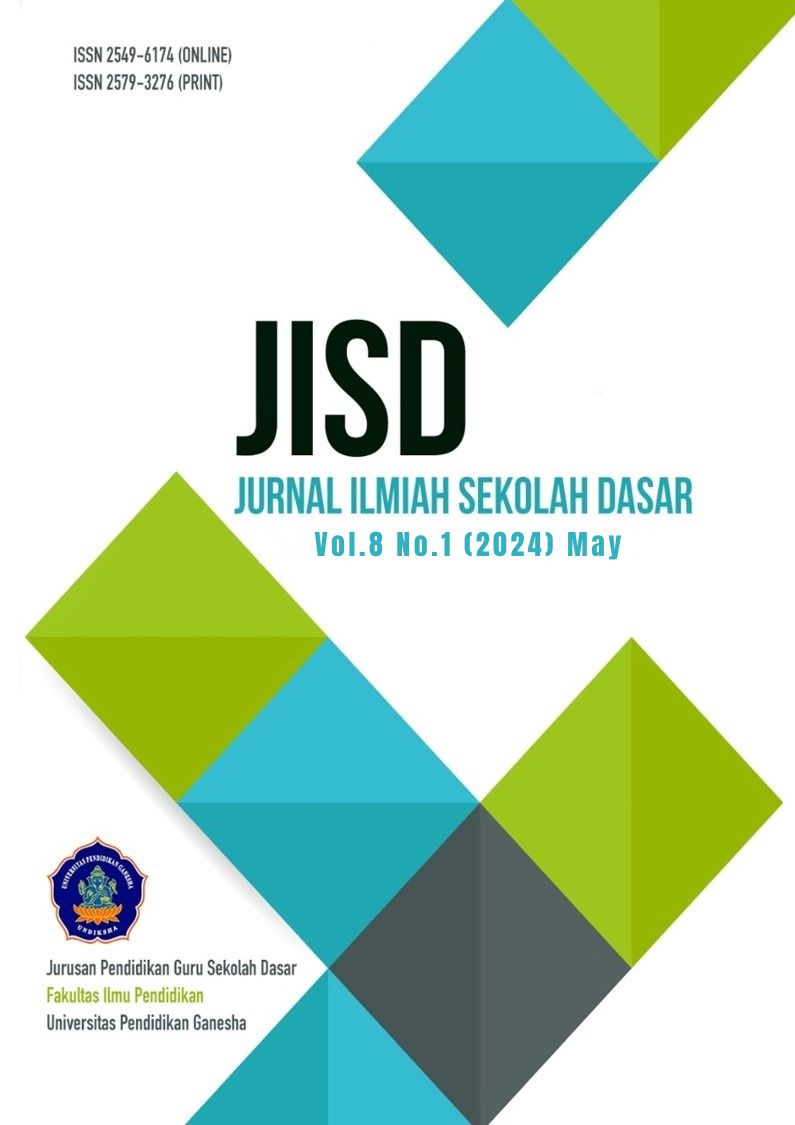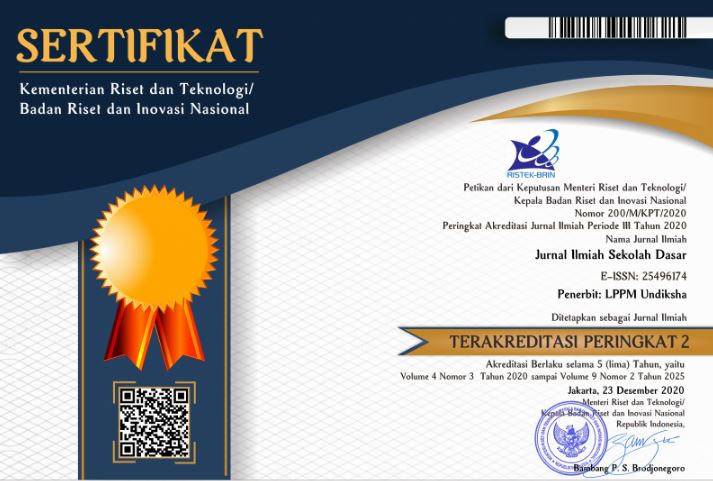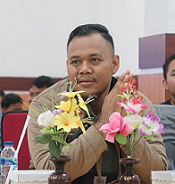Upakara Bali-based Electronic Student Worksheets on Geometry Topic for Second Grade of Elementary School
DOI:
https://doi.org/10.23887/jisd.v8i2.74010Keywords:
Electronic Student Worksheets, Ethnomathematics, Upakara Bali, GeometryAbstract
The lack of contextualization and innovation in developing learning materials for 2nd-grade elementary school geometry has become a major issue leading to students' difficulty in understanding concepts. This research aims to develop an Electronic Student Worksheets Based on Ethnomathematics Upakara Bali in Geometry for 2nd-Grade Elementary School. Trial subjects in this study include two material experts, two media experts, one 2nd-grade teacher, 6 individual trial students, and 10 small group trial students. This research utilizes the ADDIE model (analyze, design, development, implementation, evaluation). Data collection methods used were questionnaires, interviews, and observations. Data analysis techniques involved quantitative and qualitative descriptive analyses. The results of this developmental research are the Electronic Student Worksheets product, covering: (a) the design and development of an ethnomathematics-based Electronic Student Worksheets on Upakara Bali for 2nd-grade Elementary School Geometry, including analysis, design, and development stages; (b) validity test results gain criteria of excellent qualification; (c) effectiveness test belongs to teacher response, individual trial score, small group trial score belongs to excellent qualification. Hence, it can be concluded that this Electronic Student Worksheets is suitable for use in the learning process. The implication of this research is the existence of a valid and suitable Electronic Student Worksheets to enhance 2nd-grade Elementary School geometry learning within the local cultural context.
References
Amanina, A. A., & Muchlis. (2023). Development of Assessment for Learning-oriented Electronic Student Worksheets to Improve Student Learning Outcomes on Acid-base Titration Material. Jurnal Pijar Mipa, 18(4), 518–524. https://doi.org/10.29303/jpm.v18i4.5188. DOI: https://doi.org/10.29303/jpm.v18i4.5188
Bujuri, D. A. (2018). Analisis Perkembangan Kognitif Anak Usia Dasar dan Implikasinya dalam Kegiatan Belajar Mengajar. LITERASI (Jurnal Ilmu Pendidikan), 9(1), 37–50. https://www.ejournal.almaata.ac.id/index.php/LITERASI/article/view/720. DOI: https://doi.org/10.21927/literasi.2018.9(1).37-50
Costadena, N. M. M. P., & Suniasih, N. W. (2022). E-LKPD Interaktif Berbasis Discovery Learning pada Muatan IPA Materi Ekosistem. Jurnal Penelitian Dan Pengembangan Pendidikan, 6(2), 180–190. https://doi.org/10.23887/jppp.v6i2.45848. DOI: https://doi.org/10.23887/jppp.v6i2.45848
Dafid Slamet Setiana, & Nuryadi, N. (2022). Analisis Efektivitas E-LKPD (Lembar Kegiatan Peserta Didik Elektronik) Berbasis Etnomatematika Batu Akik Ditinjau dari Kemampuan Awal Siswa. Jurnal Gantang, 6(2), 113–123. https://doi.org/10.31629/jg.v6i2.3566. DOI: https://doi.org/10.31629/jg.v6i2.3566
Dewi, N. P. D. M., & Agustika, G. N. S. (2022). E-LKPD Interaktif berbasis Etnomatematika Jejahitan Bali pada Materi Bangun Datar Kelas IV SD. Mimbar PGSD Undikhsa, 10(1), 94–104. https://doi.org/10.23887/jjpgsd.v10i1.45350. DOI: https://doi.org/10.23887/jjpgsd.v10i1.45350
Fauzi, I., & Arisetyawan, A. (2020). Analisis Kesulitan Belajar Siswa pada Materi Geometri Di Sekolah Dasar. Kreano, Jurnal Matematika Kreatif-Inovatif, 11(1), 27–35. https://doi.org/10.15294/kreano.v11i1.20726. DOI: https://doi.org/10.15294/kreano.v11i1.20726
Gainsburg, J. (2008). Real-World Connections in Secondary Mathematics Teaching. Journal of Mathematics Teacher Education, 11(3), 199–219. https://doi.org/10.1007/s10857-007-9070-8. DOI: https://doi.org/10.1007/s10857-007-9070-8
Ginsburg, H. P., Lee, J. S., & Boyd, J. S. (2008). Mathematics Education for Young Children: What It is and How to Promote It. Social Policy Report, 22(1), 1–24. https://doi.org/10.1002/j.2379-3988.2008.tb00054.x. DOI: https://doi.org/10.1002/j.2379-3988.2008.tb00054.x
Graham, S., Bollinger, A., Olson, C. B., D’Aoust, C., MacArthur, C., McCutchen, D., & Olinghouse, N. (2012). Teaching elementary school students to be effective writers: A practice guide. What Works Clearinghouse, 1–103.
Gregson, R. A. M. (1962). A Rating‐Scale Method for Determining Absolute Taste Thresholds. Journal of Food Science, 27(4), 376–380. https://doi.org/10.1111/j.1365-2621.1962.tb00111.x. DOI: https://doi.org/10.1111/j.1365-2621.1962.tb00111.x
Gupta, T., Burke, K. A., & Greenbowe, T. J. (2022). Shifting The Ownership of Learning From Instructor to Students Through Student-Led Instructor-Facilitated Guided-Inquiry Learning. In Teaching Innovation in University Education: Case Studies and Main Practices, 69–98. https://doi.org/10.4018/978-1-6684-4441. DOI: https://doi.org/10.4018/978-1-6684-4441-2.ch005
Ibda, F. (2015). Perkembangan Kognitif: Teori Jean Piaget. Intelektualita, 3(1), 27–38. https://www.jurnal.ar-raniry.ac.id/index.php/intel/article/view/197.
Liesandra, S. O., & Nurafni, N. (2022). Pengembangan E-Lkpd Pada Pembelajaran Matematika Materi Geometri Datar Berbasis Etnomatematika. AKSIOMA: Jurnal Program Studi Pendidikan Matematika, 11(3), 2498. https://doi.org/10.24127/ajpm.v11i3.5560. DOI: https://doi.org/10.24127/ajpm.v11i3.5560
Masamah, U., Zain, N. K., Salsabila, A., & Maulidani, M. (2023). The Development of Islamic Integrated Geometry Student Worksheets to Facilitate Mathematic Literacy and Religious Literacy of Junior High School Students. Jurnal Pengembangan Pembelajaran Matematika, 5(1), 17–30. https://doi.org/10.14421/jppm.2023.51.17-30. DOI: https://doi.org/10.14421/jppm.2023.51.17-30
Morrar, R., Arman, H., & Mousa, S. (2017). The Fourth Industrial Revolution (Industry 4.0): A Social Innovation Perspective. Technology Innovation Management Review, 7(11), 12–20. https://timreview.ca/sites/default/files/Issue_PDF/TIMReview_November2017.pdf#page=12 DOI: https://doi.org/10.22215/timreview/1117
Muhassanah, N., Sujadi, I., & Riyadi. (2014). Analisis Keterampilan Geometri Siswa Dalam Memecahkan Masalah Geometri Berdasarkan Tingkat Berpikir Van Hiele. Jurnal Elektronik Pembelajaran Matematika, 2(1), 54–66. https://digilib.uns.ac.id/dokumen/detail/39827.
Muruganantham, G. (2015). Developing of E-Content Package by Using ADDIE Model. International Journal of Applied Research, 1(3), 52–54. https://www.researchgate.net/profile/Muruganantham-Ganesan/publication/339102976.
Mutaqin, E. J., Salimi, M., Asyari, L., & Hamdani, N. A. (2021). Realistic Mathematics Education Approach on Teaching Geometry in Primary Schools: Collaborative Action Research. Journal of Physics: Conference Series, 1987(1), 1–6. https://doi.org/10.1088/1742-6596/1987/1/012031. DOI: https://doi.org/10.1088/1742-6596/1987/1/012031
Nawaz, A., & Ghulam, M. K. (2010). Digital Literacy: An Analysis of The Contemporary Paradigms. Department of Public Administration, Gomal University, Dera Ismail Khan, Khyber Pakhtoon Khwa, Pakistan, 1(2), 19–29. https://doi.org/10.5897/IJSTER.9000011.
Nur’aini, I. L., Harahap, E., Badruzzaman, F. H., & Darmawan, D. (2017). Pembelajaran Matematika Geometri Secara Realistis Dengan GeoGebra. Matematika, 16(2), 1–6. https://doi.org/10.29313/jmtm.v16i2.3900. DOI: https://doi.org/10.29313/jmtm.v16i2.3900
Nuryati, N., & Darsinah, D. (2021). Implementasi Teori Perkembangan Kognitif Jean Piaget dalam Pembelajaran Matematika di Sekolah Dasar. Jurnal Papeda: Jurnal Publikasi Pendidikan Dasar, 3(2), 153–162. https://doi.org/10.36232/jurnalpendidikandasar.v3i2.1186. DOI: https://doi.org/10.36232/jurnalpendidikandasar.v3i2.1186
Parvathamma, N., & Pattar, D. (2013). Digital Literacy Among Student Community in Management Institutes in Davanagere District, Karnataka State, India. Annals of Library and Information Studies (ALIS), 60(3), 159–166. https://doi.org/10.56042/alis.v60i3.863.
Prahmana, R. C. I., Yunianto, W., Rosa, M., & Orey, D. C. (2021). Ethnomathematics: Pranatamangsa System And The Birth-Death Ceremonial in Yogyakarta. Journal on Mathematics Education, 12(1), 93–112. https://doi.org/10.22342/JME.12.1.11745.93-112. DOI: https://doi.org/10.22342/jme.12.1.11745.93-112
Prayoga, T., Agustika, G. N. S., & Suniasih, N. W. (2022). E-LKPD Interaktif Materi Pengenalan Bangun Datar Berbasis Etnomatematika Peserta Didik Kelas I SD. Mimbar Ilmu, 27(1), 99–108. https://doi.org/10.23887/mi.v27i1.44777. DOI: https://doi.org/10.23887/mi.v27i1.44777
Purnama, A., & Suparman, S. (2020). Studi Pendahuluan: E-LKPD Berbasis PBL untuk Meningkatkan Kemampuan Literasi Matematis Peserta Didik. JKPM (Jurnal Kajian Pendidikan Matematika), 6(1), 131. https://doi.org/10.30998/jkpm.v6i1.8169. DOI: https://doi.org/10.30998/jkpm.v6i1.8169
Purwati, N. K. R., Sumandya, I. W., & Putri, P. R. S. (2023). E-LKPD Berbasis Etnomatematika pada Materi Trigonometri. Proximal: Jurnal Penelitian Matematika Dan Pendidikan Matematika, 6(1), 164–172. https://e-journal.my.id/proximal/article/download/2122/1624. DOI: https://doi.org/10.30605/proximal.v6i1.2122
Putriyana, A. W., Auliandari, L., & Kholillah, K. (2020). Kelayakan Lembar Kerja Peserta Didik Berbasis Model Pembelajaran Search, Solve, Create and Share pada Praktikum Materi Fungi. Biodik, 6(2), 106–117. https://doi.org/10.22437/bio.v6i2.9255. DOI: https://doi.org/10.22437/bio.v6i2.9255
Rahayu, E. (2021). Problema Kesulitan Siswa Sekolah Dasar Dalam Pembelajaran Geometri. AtTàlim : Jurnal Pendidikan, 7(1), 2548–4419. https://doi.org/10.36835/attalim.v7i1.524.
Rahayuningsih, D. I. (2018). Pengembangan Lembar Kerja Peserta Didik (Lkpd) Dengan Pendekatan Saintifik Untuk Meningkatkan Hasil Belajar Mata Pelajaran Ips Bagi Siswa Kelas Iv Sekolah Dasar. Jurnal Review Pendidikan Dasar : Jurnal Kajian Pendidikan Dan Hasil Penelitian, 4(2), 726. https://doi.org/10.26740/jrpd.v4n2.p726-733. DOI: https://doi.org/10.26740/jrpd.v4n2.p726-733
Reamer, F. G. (2019). Social Work Education in a Digital World: Technology Standards for Education and Practice. Journal of Social Work Education, 55(3), 420–432. https://doi.org/10.1080/10437797.2019.1567412. DOI: https://doi.org/10.1080/10437797.2019.1567412
Salirawati, D. (2004). Penyusunan dan Kegunaan LKS Dalam Proses Pembelajaran. Jurrnal Online, 4. https://staffnew.uny.ac.id/upload/132001805/pengabdian/19penyusunnan-dan-kegunaan-lks.pdf.
Sari, B. K. (2017). Desain Pembelajaran Model Addie Dan Implementasinya Dengan Teknik Jigsaw. Prosiding Seminar Nasional Pendidikan, 87–102. http://eprints.umsida.ac.id/432/.
Tegeh, I. M., & Kirna, I. M. (2013). Pengembangan Bahan Ajar Metode Penelitian Pendidikan dengan ADDIE Model. Jurnal IKA, 11(1), 16. https://doi.org/10.23887/ika.v11i1.1145.
Turmuzi, M., Sudiarta, I. G. P., & Suharta, I. G. P. (2022). Systematic Literature Review: Etnomatematika Kearifan Lokal Budaya Sasak. Jurnal Cendekia : Jurnal Pendidikan Matematika, 6(1), 397–413. https://doi.org/10.31004/cendekia.v6i1.1183. DOI: https://doi.org/10.31004/cendekia.v6i1.1183
Vorona, S., Lubov, D., B., & Olga, L. (2020). “Visualization of Learning and Memorizing Processes Using Mobile Devices: Mind Mapping and Charting.” International Journal of Interactive Mobile Technologies, 14(21), 136–52. https://doi.org/10.3991/ijim.v14i21.18475. DOI: https://doi.org/10.3991/ijim.v14i21.18475
Widyastuti, E. (2019). Using the ADDIE model to develop learning material for actuarial mathematics. In Journal of Physics: Conference Series, 1188(1), 012052. https://doi.org/10.1088/1742-6596/1188/1/012052. DOI: https://doi.org/10.1088/1742-6596/1188/1/012052
Wiyono, M., Solihin, F., & Putro, S. S. (2018). Aplikasi Penilaian Kuliah Kerja Nyata Universitas Trunojoyo Madura Menggunakan Metode Rating Scale. Jurnal Ilmiah Rekayasa, 10(1), 23. https://doi.org/10.21107/rekayasa.v10i1.3601. DOI: https://doi.org/10.21107/rekayasa.v10i1.3601
Downloads
Published
How to Cite
Issue
Section
License
Copyright (c) 2024 I Gusti Komang Agus Angga Putra Widiarta

This work is licensed under a Creative Commons Attribution-ShareAlike 4.0 International License.
Authors who publish with the Journal Ilmiah Sekolah Dasar agree to the following terms:
- Authors retain copyright and grant the journal the right of first publication with the work simultaneously licensed under a Creative Commons Attribution License (CC BY-SA 4.0) that allows others to share the work with an acknowledgment of the work's authorship and initial publication in this journal.
- Authors are able to enter into separate, additional contractual arrangements for the non-exclusive distribution of the journal's published version of the work (e.g., post it to an institutional repository or publish it in a book), with an acknowledgment of its initial publication in this journal.
- Authors are permitted and encouraged to post their work online (e.g., in institutional repositories or on their website) prior to and during the submission process, as it can lead to productive exchanges, as well as earlier and greater citation of published work. (See The Effect of Open Access)










